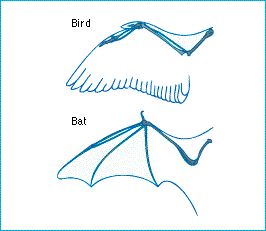Homoplasies

A homoplasy is a character shared by a set of species but not present in their common ancestor. A good example is the evolution of the eye which has originated independently in many different species. When this happens it is sometimes called a convergence. Homoplasies can be compared with homologies, which are characters shared by a set of species and are present in their common ancestor.
Note that the above definition of homoplasy is its technical definition used by biologists. A homoplasy has an older, pre-Darwinian meaning of similarity explained by a shared way of life. For example, the wings of insects, birds and bats are all needed for flying: they are homoplasious structures in the non-evolutionary, as well as the evolutionary, sense.
Figure: the wings of birds and bats are homoplasies. They are structurally different: the bird wing is supported by digit number 2, the bat wing by digits 2-5.
| Next |



